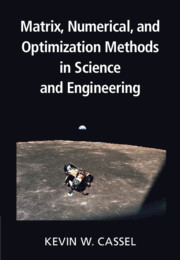Refine search
Actions for selected content:
1945 results in Engineering mathematics and programming
8 - Finite-Difference Methods for Boundary-Value Problems
- from Part II - Numerical Methods
-
- Book:
- Matrix, Numerical, and Optimization Methods in Science and Engineering
- Published online:
- 18 February 2021
- Print publication:
- 04 March 2021, pp 407-465
-
- Chapter
- Export citation
3 - Differential Eigenproblems and Their Applications
- from Part I - Matrix Methods
-
- Book:
- Matrix, Numerical, and Optimization Methods in Science and Engineering
- Published online:
- 18 February 2021
- Print publication:
- 04 March 2021, pp 155-217
-
- Chapter
- Export citation
11 - Data Analysis: Curve Fitting and Interpolation
- from Part III - Least Squares and Optimization
-
- Book:
- Matrix, Numerical, and Optimization Methods in Science and Engineering
- Published online:
- 18 February 2021
- Print publication:
- 04 March 2021, pp 560-593
-
- Chapter
- Export citation
6 - Computational Linear Algebra
- from Part II - Numerical Methods
-
- Book:
- Matrix, Numerical, and Optimization Methods in Science and Engineering
- Published online:
- 18 February 2021
- Print publication:
- 04 March 2021, pp 315-375
-
- Chapter
- Export citation
9 - Finite-Difference Methods for Initial-Value Problems
- from Part II - Numerical Methods
-
- Book:
- Matrix, Numerical, and Optimization Methods in Science and Engineering
- Published online:
- 18 February 2021
- Print publication:
- 04 March 2021, pp 466-526
-
- Chapter
- Export citation
Preface
-
- Book:
- Matrix, Numerical, and Optimization Methods in Science and Engineering
- Published online:
- 18 February 2021
- Print publication:
- 04 March 2021, pp xi-xvi
-
- Chapter
- Export citation
Index
-
- Book:
- Matrix, Numerical, and Optimization Methods in Science and Engineering
- Published online:
- 18 February 2021
- Print publication:
- 04 March 2021, pp 703-710
-
- Chapter
- Export citation
Part II - Numerical Methods
-
- Book:
- Matrix, Numerical, and Optimization Methods in Science and Engineering
- Published online:
- 18 February 2021
- Print publication:
- 04 March 2021, pp 313-314
-
- Chapter
- Export citation
Contents
-
- Book:
- Matrix, Numerical, and Optimization Methods in Science and Engineering
- Published online:
- 18 February 2021
- Print publication:
- 04 March 2021, pp vii-x
-
- Chapter
- Export citation
10 - Least-Squares Methods
- from Part III - Least Squares and Optimization
-
- Book:
- Matrix, Numerical, and Optimization Methods in Science and Engineering
- Published online:
- 18 February 2021
- Print publication:
- 04 March 2021, pp 529-559
-
- Chapter
- Export citation
1 - Vector and Matrix Algebra
- from Part I - Matrix Methods
-
- Book:
- Matrix, Numerical, and Optimization Methods in Science and Engineering
- Published online:
- 18 February 2021
- Print publication:
- 04 March 2021, pp 3-63
-
- Chapter
- Export citation
4 - Vector and Matrix Calculus
- from Part I - Matrix Methods
-
- Book:
- Matrix, Numerical, and Optimization Methods in Science and Engineering
- Published online:
- 18 February 2021
- Print publication:
- 04 March 2021, pp 218-252
-
- Chapter
- Export citation

Matrix, Numerical, and Optimization Methods in Science and Engineering
-
- Published online:
- 18 February 2021
- Print publication:
- 04 March 2021
8 - Shortest Paths
-
- Book:
- Competitive Programming in Python
- Published online:
- 03 December 2020
- Print publication:
- 17 December 2020, pp 124-137
-
- Chapter
- Export citation
15 - Exhaustive Search
-
- Book:
- Competitive Programming in Python
- Published online:
- 03 December 2020
- Print publication:
- 17 December 2020, pp 227-244
-
- Chapter
- Export citation
10 - Trees
-
- Book:
- Competitive Programming in Python
- Published online:
- 03 December 2020
- Print publication:
- 17 December 2020, pp 171-181
-
- Chapter
- Export citation
Debugging tool
-
- Book:
- Competitive Programming in Python
- Published online:
- 03 December 2020
- Print publication:
- 17 December 2020, pp 247-247
-
- Chapter
- Export citation
6 - Graphs
-
- Book:
- Competitive Programming in Python
- Published online:
- 03 December 2020
- Print publication:
- 17 December 2020, pp 88-112
-
- Chapter
- Export citation
14 - Numbers and Matrices
-
- Book:
- Competitive Programming in Python
- Published online:
- 03 December 2020
- Print publication:
- 17 December 2020, pp 214-226
-
- Chapter
- Export citation
Contents
-
- Book:
- Competitive Programming in Python
- Published online:
- 03 December 2020
- Print publication:
- 17 December 2020, pp v-viii
-
- Chapter
- Export citation
